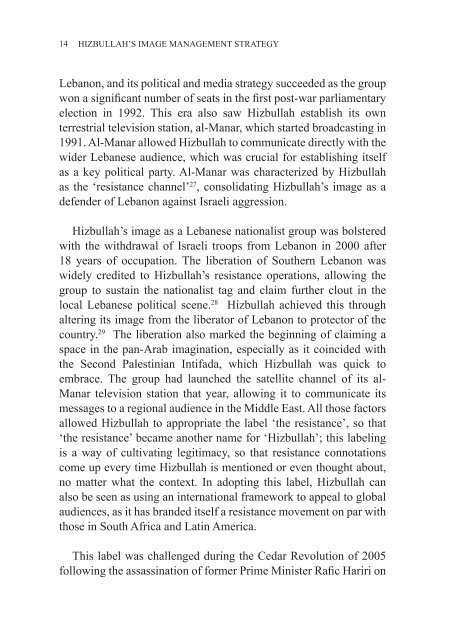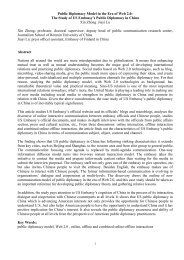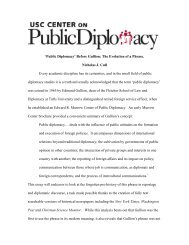Hizbullah's Image Management Strategy - USC Center on Public ...
Hizbullah's Image Management Strategy - USC Center on Public ...
Hizbullah's Image Management Strategy - USC Center on Public ...
Create successful ePaper yourself
Turn your PDF publications into a flip-book with our unique Google optimized e-Paper software.
14 HIZBULLAH’S IMAGE MANAGEMENT STRATEGY<br />
Leban<strong>on</strong>, and its political and media strategy succeeded as the group<br />
w<strong>on</strong> a significant number of seats in the first post-war parliamentary<br />
electi<strong>on</strong> in 1992. This era also saw Hizbullah establish its own<br />
terrestrial televisi<strong>on</strong> stati<strong>on</strong>, al-Manar, which started broadcasting in<br />
1991. Al-Manar allowed Hizbullah to communicate directly with the<br />
wider Lebanese audience, which was crucial for establishing itself<br />
as a key political party. Al-Manar was characterized by Hizbullah<br />
as the ‘resistance channel’ 27 , c<strong>on</strong>solidating Hizbullah’s image as a<br />
defender of Leban<strong>on</strong> against Israeli aggressi<strong>on</strong>.<br />
Hizbullah’s image as a Lebanese nati<strong>on</strong>alist group was bolstered<br />
with the withdrawal of Israeli troops from Leban<strong>on</strong> in 2000 after<br />
18 years of occupati<strong>on</strong>. The liberati<strong>on</strong> of Southern Leban<strong>on</strong> was<br />
widely credited to Hizbullah’s resistance operati<strong>on</strong>s, allowing the<br />
group to sustain the nati<strong>on</strong>alist tag and claim further clout in the<br />
local Lebanese political scene. 28 Hizbullah achieved this through<br />
altering its image from the liberator of Leban<strong>on</strong> to protector of the<br />
country. 29 The liberati<strong>on</strong> also marked the beginning of claiming a<br />
space in the pan-Arab imaginati<strong>on</strong>, especially as it coincided with<br />
the Sec<strong>on</strong>d Palestinian Intifada, which Hizbullah was quick to<br />
embrace. The group had launched the satellite channel of its al-<br />
Manar televisi<strong>on</strong> stati<strong>on</strong> that year, allowing it to communicate its<br />
messages to a regi<strong>on</strong>al audience in the Middle East. All those factors<br />
allowed Hizbullah to appropriate the label ‘the resistance’, so that<br />
‘the resistance’ became another name for ‘Hizbullah’; this labeling<br />
is a way of cultivating legitimacy, so that resistance c<strong>on</strong>notati<strong>on</strong>s<br />
come up every time Hizbullah is menti<strong>on</strong>ed or even thought about,<br />
no matter what the c<strong>on</strong>text. In adopting this label, Hizbullah can<br />
also be seen as using an internati<strong>on</strong>al framework to appeal to global<br />
audiences, as it has branded itself a resistance movement <strong>on</strong> par with<br />
those in South Africa and Latin America.<br />
This label was challenged during the Cedar Revoluti<strong>on</strong> of 2005<br />
following the assassinati<strong>on</strong> of former Prime Minister Rafic Hariri <strong>on</strong>











